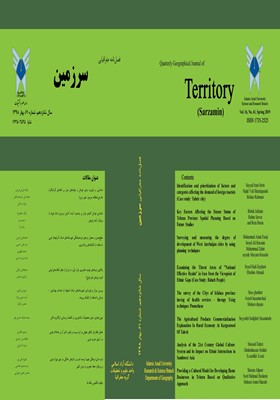شناسایی عوامل کلیدی مؤثر بر وضعیت آینده آمایش سرزمین استان تهران با رویکرد آینده پژوهی
محورهای موضوعی : آمایش سرزمین
بابک جعفریان
1
,
رحیم سرور
2
,
رضا برنا
3
![]()
1 - دانشگاه آزاد اسلامی، واحد علوم و تحقیقات، تهران
2 - دانشگاه آزاد اسلامی واحد علوم و تحقیقات
3 - علوم تحقیقات
کلید واژه: "آینده پژوهی", "استان تهران", "آمایش", "تحلیل اثرات متقاطع", " آمایش سرزمین",
چکیده مقاله :
نوشتار حاضر با هدف شناسایی عوامل کلیدی مؤثر بر وضعیت آینده آمایش سرزمین استان تهران با رویکردآینده پژوهی انجام گرفت. این پژوهش از لحاظ راهبرد هدفگذاری کاربردی و روش آن توصیفی - تحلیلی و بر اساس روشهای آینده پژوهی، تبیینی میباشد. داده-های نظری با روش اسنادی و دادههای تجربی با روش پیمایشی بر اساس روش دلفی تهیه شده است. جامعه آماری پژوهش 20 نفر از خبرگان و متخصصان شهری صاحبنظر در حوزه برنامهریزی منطقهای، فضایی و آمایشی بهصورت نمونهگیری هدفمند انتخاب شده بود. جهت تجزیهوتحلیل اطلاعات بهدستآمده از روشهای دلفی، تحلیل اثرات متقاطع و از نرمافزار MIC MAC استفادهشده است. نتایج این پژوهش نشان داد پراکندگی متغیرهای کلیدی و مؤثر بر وضعیت آینده آمایش سرزمین استان تهران، سیستمی ناپایدار دارند و پژوهش حاکی از آن میباشد که از میان 64 عامل بررسیشده در این تحقیق، 22 عامل بهعنوان عامل کلیدی مؤثر بر آینده وضعیت تحققپذیری طرحهای آمایش سرزمین استان تهران، انتخابشدهاند. بخش عمدهای از این عوامل کلیدی در گروه متغیرهای تاثیرگذار و دوگانه تمرکز داشتند.
Aiming at identifying the key factors which may affect the future status of Tehran Province spatial planning, this study was conducted with a future studies approach. This study is an applied study in terms of targeting strategy and its methodology is of descriptive-analytical and regarding the future studies methods it is an explanatory one. Following the Delphi method, the theoretical and practical data have been collected using documentary and survey research techniques, respectively. To carry out this study, a total of 20 urban experts who were professional in regional, spatial planning areas were chosen based on purposive sampling method. MIC MAC was used to analyze the gained information from Delphi methods and to carry out the cross-impact analysis. The results of this study indicated that the dispersion of key and effective variables of the future status of Tehran Province spatial planning has an unstable system. The study also showed that out of 64 examined factors in this study, 22 key factors may affect the future status of Tehran Province spatial planning. A great deal of such key factors has been concentrated in the effective and double variables group.
_||_


